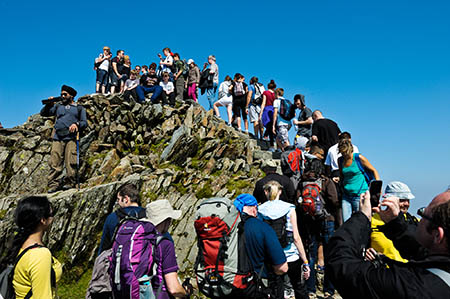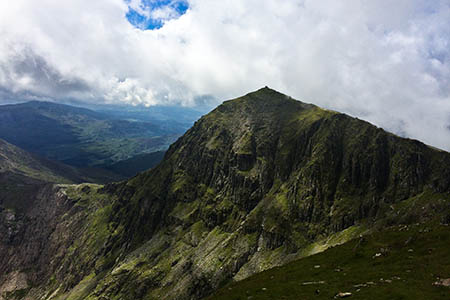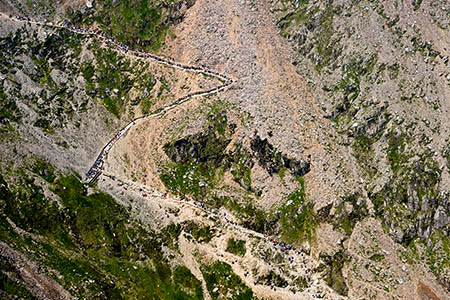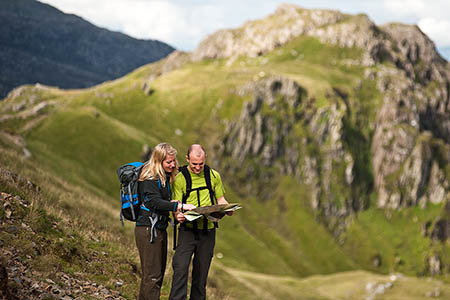Mountaineers say their views are being ignored by a national park trying to make Wales’s highest mountain ‘safe’.
The British Mountaineering Council said Snowdonia National Park Authority’s attempts are misguided and risk misleading the public into thinking Snowdon is just another tourist attraction.
The council, which represents hillwalkers and climbers in England and Wales, said people needed to be taught the skills to use mountains and criticised a Snowdonia authority statement saying taking children up the highest hills could put them off the outdoors.
The row follows comments made by deputy coroner Nicola Jones at the inquest into the Good Friday death of 21-year-old Dylan Rattray when he fell 180m (600ft) after following a path that petered out.
The coroner said the authority had a duty to take action on these ‘false paths’ and it agreed to remove them from the summit of the 1,085m (3,560ft) mountain.
Snowdonia National Park Authority also said earlier this month that families should think about walking on alternative routes rather than heading for mountains’ summits.
Mair Huws, the authority’s head of wardens and access, said: “Walking on mountains can be very challenging even in the summer and taking tired young children to a mountain summit isn’t fun.
“It can result in children having very negative attitudes towards walking for the rest of their lives.
“Please remember that you don’t have to venture to the high summits to enjoy the beauty of Snowdonia.”
The BMC said these approaches were misguided and reflected short-term thinking. “With Snowdon seeing 477,000 walkers in 2013, a long-term plan is needed to address the key problems of preventable accidents and environmental damage,” it said. “Central government funding to the park should also be upped, to reflect Snowdon’s status as Britain’s busiest mountain.”
Elfyn Jones, BMC access and conservation officer for Wales, said: “In the last few years there has been a huge increase in the numbers of people on Snowdon. In 2013 there was an increase of 23 per cent on the previous year.
“Many of these visitors are unprepared casual walkers, and there has been a significant increase in the number of avoidable callouts to rescue teams, parking problems, traffic congestion and litter.
“The current practice of managing the paths by reacting to individual problems such as ‘landscaping’ and smoothing out natural obstacles has done nothing to alleviate the issues. If anything it has created a bigger problem as many walkers and visitors are under the impression that Snowdon is a tourist attraction, similar to a fully waymarked country park trail.
“User groups such as the BMC have had little opportunity to input into the strategic management of the mountain.
“The park authority should prioritise education and awareness-raising, putting effort into ensuring the visitor is better prepared, instead of treating Snowdon as if it was an urban environment and attempting to physically engineer it into being ‘safe’. This is simply impossible.”
Mr Jones said: “It is disappointing that the park authority is sending out messages that are being interpreted as telling families with young children to stay away from summits.
“If parents have the right knowledge and experience there is no reason why children cannot have rewarding experiences on mountain summits. In fact many people who go on to lead active, healthy, outdoor lives cite the experience of being taken into the hills as a youngster as vital in forming their later perceptions.”
The BMC also said removing paths that lead to hazardous ground was the wrong strategy.
Jon Garside, BMC training officer, said: “To some people it might seem easy to blame ‘misleading’ paths for accidents. But simply removing paths is not the answer.
“It is wrong to say that paths, summits or any other physical aspect of the mountain environment are inherently dangerous. The key factor is people themselves and their ability to deal with the hazards they encounter.
“To stay safe people must be taught to rely on their heads, not cues provided by artificial pointers.
“Promoting and teaching the skills needed to operate in mountain environments is not a quick fix; it takes time, patience and resources.
“But it is ultimately a far better insurance against accidents than ‘landscape improvements’. This is where the focus of the national park’s efforts should be.”
The council said Government cuts to cash received by the park authority exacerbated the problems.
Mr Jones said: “With continued cutbacks to national park funding, the park authority is clearly struggling with the resources it has available to deal with the considerable problems that managing an area such as Snowdon poses.
“Snowdon poses unique and special problems for any organisation trying to manage and conserve its special qualities.
“With over 477,000 walkers on its main paths each year it is arguably the busiest and most popular mountain in the world. It needs a vision and a funded work programme that’s agreed and shared with all stakeholders to provide the resources required to protect the special qualities of this unique and often abused mountain area.”




Pete
15 August 2014Christ on a bike. The main hazard surely lies in being trampled by a crowd surge near what's left of the summit?
madcarew
15 August 2014Well said BMC!
Paul B
15 August 2014Yep, it's a mountain albeit popular and a train goes up it, just like the Eiger!
Good response from Jon G.
Evan Owen
16 August 2014They advertise the fact that they put a concrete bunker on the top and sell tea and cake which brings in the tourists who have no idea what a mountain is, how the elevation affects the weather or how dangerous it can get in the blink of an eye.
Said bunker is one of the biggest financial risks the Authority faces, the other one is their pension scheme. Of late their very existence is in question, that should teach them for turning 80% of Gwynedd into a social and economic desert.
Martin Richardson
17 August 2014Ridiculous. You should see some of the mountains in Europe that children as young as six ascend on the continent. For example, today I saw young children climbing to near 3000m high on Musala, Bulgaria in the rain. Or Norway's Galdhoppigen with deep snow.
Restricting children to Thorpe Cloud or Catbells must be a turn off.
Ian
18 August 2014Evan, good point about the cafe.
I agree with you Martin; though I think in the Alps the parents are more likely to be mountaineers rather than tourists, which is the fundamental problem in this country.
They (tourists) are encouraged to get out and up there by all the varied commercial and not so commercial interests. Then the voluntary rescue teams have to sweep up the problems.